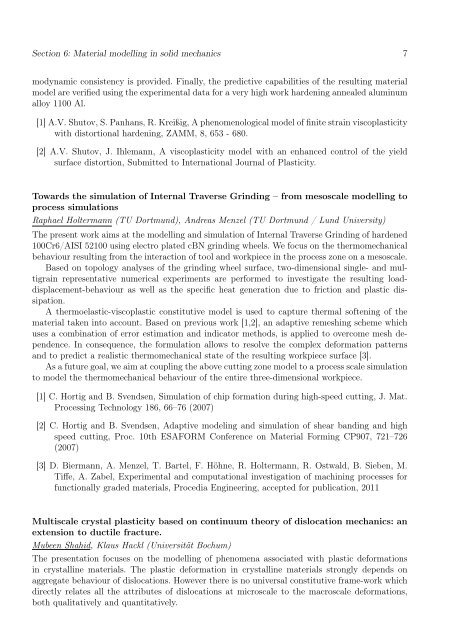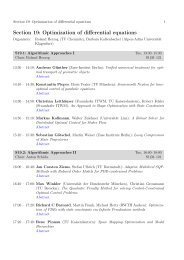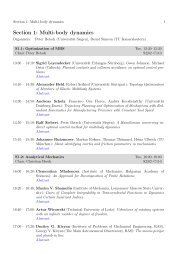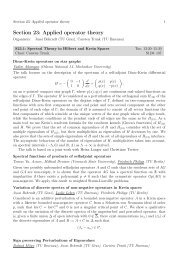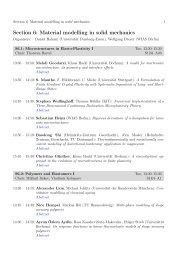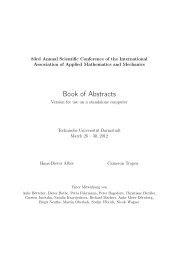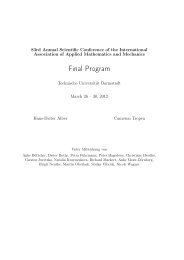Section 6: Material modelling in solid mechanics - GAMM 2012
Section 6: Material modelling in solid mechanics - GAMM 2012
Section 6: Material modelling in solid mechanics - GAMM 2012
Create successful ePaper yourself
Turn your PDF publications into a flip-book with our unique Google optimized e-Paper software.
<strong>Section</strong> 6: <strong>Material</strong> <strong>modell<strong>in</strong>g</strong> <strong>in</strong> <strong>solid</strong> <strong>mechanics</strong> 7<br />
modynamic consistency is provided. F<strong>in</strong>ally, the predictive capabilities of the result<strong>in</strong>g material<br />
model are verified us<strong>in</strong>g the experimental data for a very high work harden<strong>in</strong>g annealed alum<strong>in</strong>um<br />
alloy 1100 Al.<br />
[1] A.V. Shutov, S. Panhans, R. Kreißig, A phenomenological model of f<strong>in</strong>ite stra<strong>in</strong> viscoplasticity<br />
with distortional harden<strong>in</strong>g, ZAMM, 8, 653 - 680.<br />
[2] A.V. Shutov, J. Ihlemann, A viscoplasticity model with an enhanced control of the yield<br />
surface distortion, Submitted to International Journal of Plasticity.<br />
Towards the simulation of Internal Traverse Gr<strong>in</strong>d<strong>in</strong>g – from mesoscale <strong>modell<strong>in</strong>g</strong> to<br />
process simulations<br />
Raphael Holtermann (TU Dortmund), Andreas Menzel (TU Dortmund / Lund University)<br />
The present work aims at the <strong>modell<strong>in</strong>g</strong> and simulation of Internal Traverse Gr<strong>in</strong>d<strong>in</strong>g of hardened<br />
100Cr6/AISI 52100 us<strong>in</strong>g electro plated cBN gr<strong>in</strong>d<strong>in</strong>g wheels. We focus on the thermomechanical<br />
behaviour result<strong>in</strong>g from the <strong>in</strong>teraction of tool and workpiece <strong>in</strong> the process zone on a mesoscale.<br />
Based on topology analyses of the gr<strong>in</strong>d<strong>in</strong>g wheel surface, two-dimensional s<strong>in</strong>gle- and multigra<strong>in</strong><br />
representative numerical experiments are performed to <strong>in</strong>vestigate the result<strong>in</strong>g loaddisplacement-behaviour<br />
as well as the specific heat generation due to friction and plastic dissipation.<br />
A thermoelastic-viscoplastic constitutive model is used to capture thermal soften<strong>in</strong>g of the<br />
material taken <strong>in</strong>to account. Based on previous work [1,2], an adaptive remesh<strong>in</strong>g scheme which<br />
uses a comb<strong>in</strong>ation of error estimation and <strong>in</strong>dicator methods, is applied to overcome mesh dependence.<br />
In consequence, the formulation allows to resolve the complex deformation patterns<br />
and to predict a realistic thermomechanical state of the result<strong>in</strong>g workpiece surface [3].<br />
As a future goal, we aim at coupl<strong>in</strong>g the above cutt<strong>in</strong>g zone model to a process scale simulation<br />
to model the thermomechanical behaviour of the entire three-dimensional workpiece.<br />
[1] C. Hortig and B. Svendsen, Simulation of chip formation dur<strong>in</strong>g high-speed cutt<strong>in</strong>g, J. Mat.<br />
Process<strong>in</strong>g Technology 186, 66–76 (2007)<br />
[2] C. Hortig and B. Svendsen, Adaptive model<strong>in</strong>g and simulation of shear band<strong>in</strong>g and high<br />
speed cutt<strong>in</strong>g, Proc. 10th ESAFORM Conference on <strong>Material</strong> Form<strong>in</strong>g CP907, 721–726<br />
(2007)<br />
[3] D. Biermann, A. Menzel, T. Bartel, F. Höhne, R. Holtermann, R. Ostwald, B. Sieben, M.<br />
Tiffe, A. Zabel, Experimental and computational <strong>in</strong>vestigation of mach<strong>in</strong><strong>in</strong>g processes for<br />
functionally graded materials, Procedia Eng<strong>in</strong>eer<strong>in</strong>g, accepted for publication, 2011<br />
Multiscale crystal plasticity based on cont<strong>in</strong>uum theory of dislocation <strong>mechanics</strong>: an<br />
extension to ductile fracture.<br />
Mubeen Shahid, Klaus Hackl (Universität Bochum)<br />
The presentation focuses on the <strong>modell<strong>in</strong>g</strong> of phenomena associated with plastic deformations<br />
<strong>in</strong> crystall<strong>in</strong>e materials. The plastic deformation <strong>in</strong> crystall<strong>in</strong>e materials strongly depends on<br />
aggregate behaviour of dislocations. However there is no universal constitutive frame-work which<br />
directly relates all the attributes of dislocations at microscale to the macroscale deformations,<br />
both qualitatively and quantitatively.


